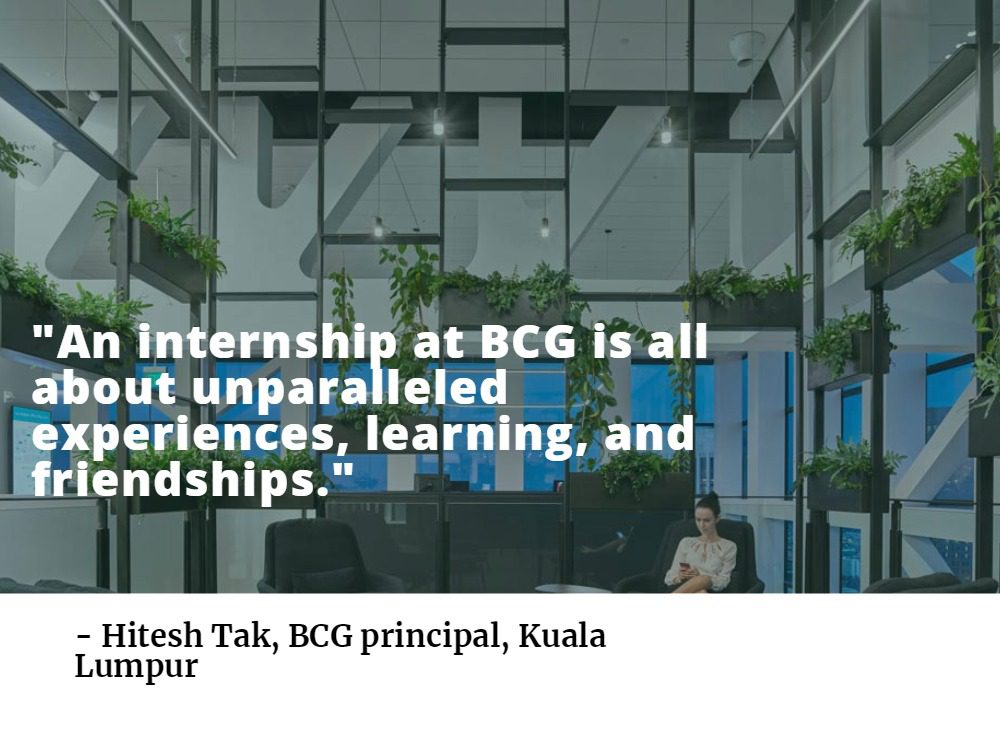How Can You Get a Job at Boston Consulting Group in 2018?

Boston Consulting Company—a global management consulting firm— has offices across more than 90 cities and 50 countries, advising clients in the private, public, and not-for-profit sectors, including a healthy chunk of Fortune 500 companies. Considered one of the most prestigious management consulting firms in the world, BCG was ranked fourth in Fortune’s “100 Best Companies to Work For” in 2018.
But, how can an MBA help you land a BCG job?
Working for BCG
According to Management Consulted, BCG has a demanding recruiting and hiring system. The firm hires undergrads as associates who work for two to three years before moving on or pursuing an MBA. However, it is very difficult and highly unlikely for an associate to make the leap to consultant without an MBA. If you’re hired as an MBA, you enter as a consultant with plenty of room for growth—to project team leader, principal, and then, finally, as a partner partner.
According to former BCG senior partner Lucy Brady, the company looks for a candidate’s record of academic and professional success, but also want to hire candidates who have overcome setbacks.
“We look for resiliency and adaptability, and the ability to learn from your mistakes and grow from them,” she said in a previous interview.
CNN revealed that 11.72 percent of MBAs want to work for BCG. However, BCG’s recruiting process is demanding, with Glassdoor previously ranking the firm among the most difficult companies to interview with.
The high job demand and lengthy interview process isn’t without reason: MBAs typically thrive at BCG due to the companies the emphasis on career development. BCG’s PTO (predictability, teaming, and open communication) policies allow for a healthy work-life balance for employees, which has paid numerous dividends. Internal surveys have shown that the program has led to a 74 percent increase in reported intentions to stay with the company for the long term. BCG was also among the companies that signed the 2016 White House Equal Pay Pledge.
BCG Recruiting on Campus
BCG actively recruits students on college and university campuses around the world. Campus visits are a way for students to connect with BCG, learn more about potential job opportunities, and feel out whether a career at BCG is a good fit.
“We have a presence at many of the top universities across the U.S., including Harvard, Stanford, the University of Pennsylvania, Northwestern, University of Michigan, Duke, and the University of Texas,” Tina Gao, BCG recruiting director, said in a previous interview. “We come to campus and hold a presentation to introduce the company and then are available for Q&A sessions. We also come back to help people train for our interviews and learn more about the company. We’ll come back to campus to interview the candidates we choose.”
You can see more upcoming BCG on campus events here. However, if your campus does not have a dedicated page, BCG encourage students to complete an online application for consulting internships.
BCG Internships
BCG’s consulting internship programs can be a great opportunity for students to get a feel for the the life of a consultant. BCG Associate and Consultant interns work with current BCG consultants, and are expected to contribute to a real client project. Interns are considered as true case team members and are tasked with everything from working on client projects to socializing with colleagues.

According to BCG, internships vary depending on the project or location. Some interns are expected to travel, but do return to their home offices at the end of each week for special events and social activities. Orientation and training sessions ease interns int their roles before being assigned to a case that aligns with their personal and professional goals, as well as the firm’s business needs.
BCG accepts online applications from exceptional business school, engineering, science, law, and humanities students who are nearing the completion of their undergraduate or graduate studies.
BCG MBA Fellows
If you’re an MBA who wants to get your foot in the door at BCG, it’s worth looking into the BCG Fellows MBA Program, which provides top applicants with monetary awards and individual mentorship by BCG consultants.
The fellow program is only available to full-time MBAs studying at the following business programs: Columbia Business School, Fuqua School of Business, Kellogg School of Management, Harvard Business School, MIT Sloan School of Management, Stanford Graduate School of Business, Stern School of Business, Tuck School of Business, Anderson School of Management, Booth School of Business, Ross School of Business, Darden School of Business, The Wharton School and Yale School of Management.
BCG MBA Salaries
If you score a job at BCG, you’ll also be earning a big paycheck—well worth the hours of MBA studies and the rigorous recruiting process. According to Management Consulted, MBAs hired a BCG make earn the following within their first year of employment:
- Signing Bonus: Up to $30,000
- Base: $147,000
- Relocation: $2,000-8,000
- Performance Bonus: up to $44,100
- Retirement: Profit-sharing into a 401k
The QS World MBA Tour Is Coming To These Select Cities

There are few better opportunities to learn about the exemplary business school opportunities than at an MBA fair. And luckily, for many prospective MBA students, that opportunity will soon be arriving in their city with the QS World MBA Tour.
What Should You Study? Finance vs. Marketing MBAs

George Harrison, in his final album Brainwashed, has a line in a song that goes, “We pay the price with a spin of a wheel / with a roll of a dice / Ah yeah, you pay your fare and if you don’t know where you’re going / any road will take you there.”
Tech’s Greatest Age of Innovation Happened Already, According to New Stanford Research

As each individual technological revolution changes the pace of advancement, new data from the Stanford Graduate School of Business reveals the a small handful of years changed our technological trajectory more than any time in human history.
What is the Influence Line? A Stanford GSB alum explains.

Stanford Graduate School of Business alum Maria Lambert, MBA ’12, recently discussed the foundational idea of an “Influence Line“—an exercise in which one judge’s themselves against their peers, finding out who among themselves are the most influential compared to the others. It’s an uncomfortable process, but one, Lambert believes, can break huge barriers in producing positive feedback.
In a recent Quartz Work article, Lambert explains that the process of privately ranking peers is something we do constantly—subconsciously or not—but to make that list public requires that we reveal our “true beliefs and own our choices.” As she explains in the article, “to fully know ourselves, we need to know how we’re perceived. And that requires a rare type of honest, in-the-moment feedback that … the Influence Line is designed to elicit.”
The Influence Line exercise also elicits a great deal of internal conflict, as Lambert notes, but it doesn’t end with rankings, which is simply “the catalyst for eliciting unspoken feedback and emotions.” At Stanford, Lambert explained that her group “spent the next several sessions honestly discussing what came up for us during the exercise,” which revealed how much Lambert had left unsaid.
As brutal as the exercise can be, its efficacy has been proven. Lambert devised a “gentler” version of the Influence Line thought experiment for leaders:
- Select 5 to 12 people from your organization or network.
- Rank everyone—including you—from ascending to descending influence and explain each ranking.
- Reflect. What themes emerge?
- Identify unspoken feedback
- Evaluate yourself. Which assumptions support your perceived level of influence?
Lambert offers a few concluding words: “Sharing feedback is not easy; asking for feedback is usually harder. Yet, our growth as leaders comes from uncovering our blind spots, and then with kindness helping others to do the same. Learning comes from stepping out of our comfort zones.”
Where Did Tex-Mex Cuisine Come From, Anyway? Stanford GSB Investigates

Cultural crossover consumerism often as hard to define as it is to track down. From the origins of craft beer, to new styles of cuisine, tracing the origins of these now normalized products can be a never-ending quest.
The Stanford Graduate School of Business recently dove into that calls the authenticity of the Tex-Mex category into question and explores how the mysterious cuisine came to be.
In a new study coauthored by Lane Professor of Organizations Glenn R. Carroll and former Chicago magazine dining critic Dennis R. Wheaton, the duo analyzed how so-called “Tex-Mex” food emerged. They point to an influential 1972 cookbook entitled “The Cuisines of Mexico” by Diane Kennedy.
According to the authors, Kennedy “drew a bright line between the types of Mexican food served on either side of the U.S.-Mexico border.” Her intention was to “protect the purity of the Mexican category [and] advance the idea that Americanized Mexican food was inferior and inauthentic compared to the cuisines of Mexico.”
Carroll and Wheaton noted some major sociological factors that influenced the emergence of Tex-Mex, namely the cross-border race and class tensions between “Mexicans and poor Mexican-American immigrants, as well as between white Americans and Mexican-Americans.”
Despite Kennedy’s assessment of Tex-Mex as a derogatory and denigrating label, the cuisine—loosely defined by corn chips, crispy tacos, burritos, chili con carne, nachos, fajitas, and combination plates slathered in yellow cheese—flourished in restaurants that catered primarily to non-Mexicans e.g. Taco Bell, Chipotle, Chi-Chi’s, and El Torito.
The study incorporates a quote from Texas food writer Robb Walsh, whose defends the legacy of Tex-Mex, offering a more optimistic take on the mass-produced foodstuff.
“We can all thank Diana Kennedy for inadvertently granting Tex-Mex its rightful place in food history,” Walsh says.
“By convincing us that Tex-Mex wasn’t really Mexican food, she forced us to realize that it was something far more interesting: America’s oldest regional cuisine.”
You can read more about Stanford’s look into the history of Tex-Mex here.
